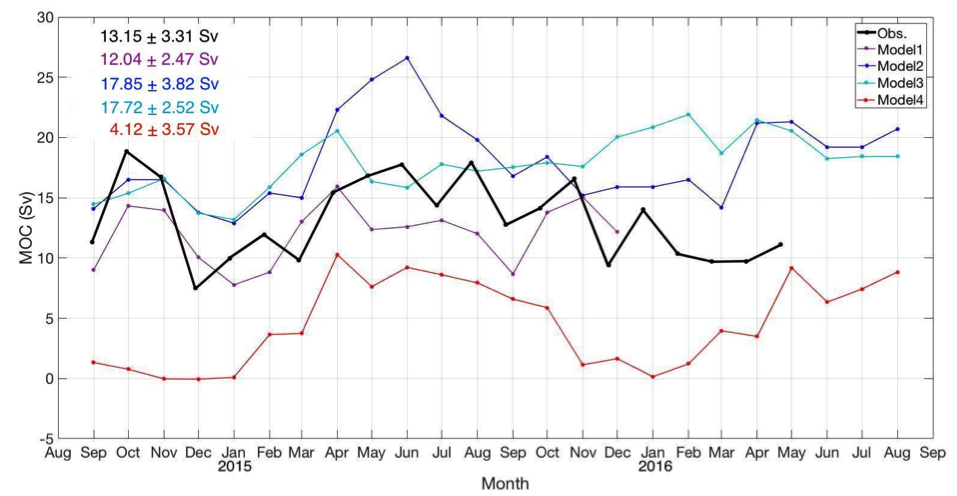In the summer of 2016, the OSNAP team collected data from the full array for the first time. Prior to publishing the first estimate of the meridional overturning circulation (MOC) this coming fall, we invited the ocean community to predict the overturning variability at the OSNAP line. Four groups entered this OSNAP challenge by submitting predictions from September 2014 (initial deployment of the OSNAP line) to August 2016. This OSNAP challenge was certainly challenging given that there were no previous OSNAP data from which to base the predictions. As such, we are grateful to the modelling community for participating in such a speculative activity.
Results
A preliminary analysis from OSNAP yields a mean MOC of 13.15 Sv with a standard deviation of 3.31 Sv during the 21-month period for September 2014 – May 2016. All predictions are shown in Figure 1. We assessed the accuracy of each prediction by both the root-mean-square-error (RMSE) from the observed time series and its temporal correlation (r) with the observed time series.
Table 1. Skill of the four predictions, ranked according to RMSE.
| Model # | Group | RMSE (Sv) | Correlation (r) |
| 1 | Ben Moat (NOC, UK) | 3.30 | 0.59 |
| 2 | Laura Jackson (Met Office, UK) | 5.87 | 0.50 |
| 3 | Charlène Feucher (University of Alberta, Canada) | 6.34 | -0.14 |
| 4 | Andrea Storto (CMCC, Italy) | 9.86 | 0.33 |
| Mean of predictions | 6.34 |
Winner
Ben Moat and his group from the National Oceanography Centre (NOC) in Southampton, UK won the competition with the lowest RMSE and highest correlation. Congrats to Ben and his colleagues! For their efforts they will receive the grand prize of OSNAP T-shirts!

Figure 1. The MOC time series for 2014-2016. The black line shows the observational time series. Colored lines show the four entries (ranked according to RMSE). Numbers in the upper left hand corner indicate the mean MOC plus/minus one standard deviation for each of the submitted time series. Note: Instrument failures near the end of the two-year deployment limited the OSNAP observational estimate to 21 months (September 2014 – May 2016).
More on the prediction
If you would like to know more about how each prediction was made, here are links to blog entries by some of the participants:
[1] OSNAP Challenge by Charlène Feucher, University of Alberta
One response to “OSNAP Challenge 2017”